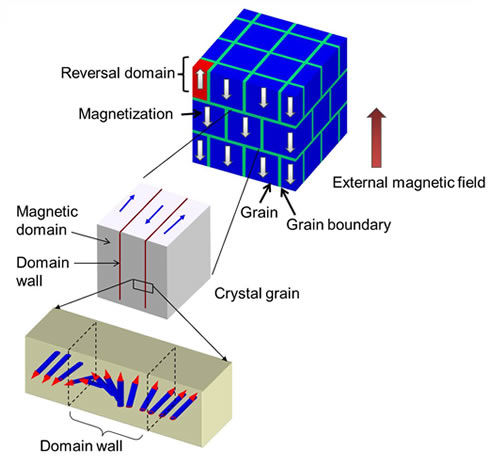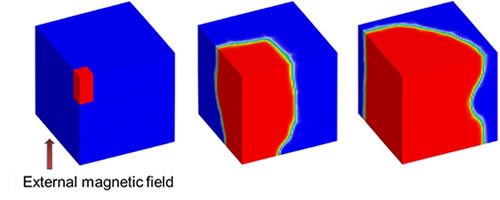Archived content
NOTE: this is an archived page and the content is likely to be out of date.
Fujitsu Develops New Simulation Technology for Designing Magnetic Materials
Paves the way to developing magnetic materials which do not rely on heavy rare earth elements
Fujitsu Limited
-
[1] Magnetization reversal
The reversal of magnetization caused by magnetic fields or electrical currents.
-
[2] K computer
A supercomputer jointly developed by RIKEN and Fujitsu.
-
[3] Heavy rare earth elements
Includes extremely scarce rare earth elements such as dysprosium. Reducing usage levels is a critical issue.
-
[4] Finite-element method
A method of numerical analysis. Widely used in structural analysis and magnetic-field analysis.
-
[5] Micromagnetics
A method of analyzing the fine structure of a magnetic material. In a computer simulation, if the magnetic material is divided into regions the size of a few atoms, the computing time is enormous.
-
[6] Simulations performed on the K computer
Simulations performed on the K computer Performed as a general-purpose simulation, grant number hp120086 (principal investigator: Yoshihiro Gohda, The University of Tokyo).
-
[7] Magnetic-domain structure
In order to reduce magnetic energies in the interior of a magnetic material, it is divided into minute regions called magnetic domains. The boundary region between magnetic domains is called a domain wall.
-
[8] First-principle electronic structure calculations
A method of calculating characteristics of substances on an atomic level based on quantum mechanics (first principles).
About Fujitsu
Fujitsu is the leading Japanese information and communication technology (ICT) company offering a full range of technology products, solutions and services. Approximately 170,000 Fujitsu people support customers in more than 100 countries. We use our experience and the power of ICT to shape the future of society with our customers. Fujitsu Limited (TSE:6702) reported consolidated revenues of 4.4 trillion yen (US$47 billion) for the fiscal year ended March 31, 2013. For more information, please see http://www.fujitsu.com.
All company or product names mentioned herein are trademarks or registered trademarks of their respective owners. Information provided in this press release is accurate at time of publication and is subject to change without advance notice.
Date: 05 September, 2013
City: Tokyo
Company:
Fujitsu Limited,
,
,
,
,
,
,
,
,
,
,
,
,

